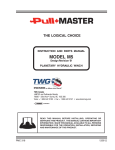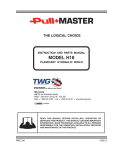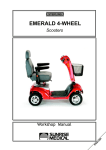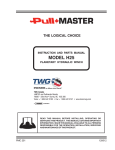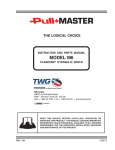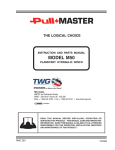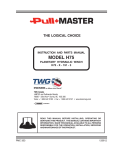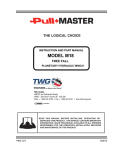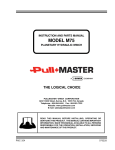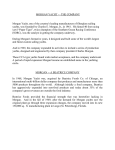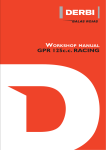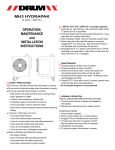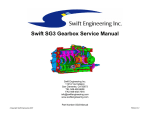Download Model PL5 Boom Swinger Service Manual
Transcript
THE LOGICAL CHOICE
INSTRUCTION AND PARTS MANUAL
MODEL PL5 BOOM SWINGER
PLANETARY HYDRAULIC WINCH
TWG Canada
LANTEC and Pullmaster Brands
19350 – 22nd Ave • Surrey, BC V3S 3S6
Voice: + 1 604-547-2100 • Fax: + 1 604-547-2147 • www.team-twg.com
READ THIS MANUAL BEFORE INSTALLING, OPERATING OR
SERVICING THIS PRODUCT. THIS MANUAL CONTAINS IMPORTANT
INFORMATION. MAKE THIS MANUAL AVAILABLE TO ALL PERSONS
RESPONSIBLE FOR THE OPERATION, INSTALLATION, SERVICING
AND MAINTENANCE OF THIS PRODUCT.
PMC 327
120612
Effective 2011/10/01
SUPERSEDES ALL PRIOR WARRANTIES
LIMITED WARRANTY
50130-0
Seller warrants that each article (whether Gear Drive Products, Brake Products and/or Winch Products, all of which are covered
hereunder) sold under this order shall at the time of shipment (i) conform to applicable specifications, and (ii) be free from
defects in material and workmanship during normal and ordinary use and service (the "Warranty").
Buyer's exclusive remedy and Seller's sole obligation under this Warranty shall be, at Seller's option, to repair or replace any
article or part thereof which has proven to be defective, or to refund the purchase price of such article or part thereof. Buyer
acknowledges that Buyer is knowledgeable concerning the articles covered by this Warranty and sold in connection therewith
which are being purchased, that Buyer has reviewed this Warranty and that the remedies provided hereunder are adequate
and acceptable to Buyer.
This Warranty shall expire one (1) year from the date the article is first shipped by Seller. Notice of claimed breach of this
Warranty must be given by Buyer to Seller within the applicable period. Such notice shall include an explanation of the claimed
warranty defect and proof of date of purchase of the article or part thereof for which warranty coverage is sought. No
allowances shall be made by Seller for any transportation, labor charges, parts, "in and out" costs, adjustments or repairs, or
any other work, unless such items are authorized in writing and in advance by Seller. Nor shall Seller have any obligation to
repair or replace items which by their nature are expendable.
If an article is claimed to be defective in material or workmanship, or not to conform to the applicable specifications, Seller will
either examine the article at Buyer's site or issue shipping instructions for return to Seller. This Warranty shall not extend to any
articles or parts thereof which have been installed, used, or serviced otherwise than in conformity with Seller's applicable
specifications, manuals, bulletins, or instructions, or which shall have been subjected to improper installation, operation, or
usage, misapplication, neglect, incorrect installation, overloading, or employment for other than normal and ordinary use and
service. This Warranty shall not apply to any article which has been repaired, altered or disassembled, or assembled by
personnel other than those of Seller. This Warranty shall not apply to any article upon which repairs or alterations have been
made (unless authorized in writing and in advance by Seller). This Warranty shall not apply to any articles or parts thereof
furnished by Seller to Buyer's specifications and/or furnished by Buyer or acquired from others at Buyer's request.
SELLER MAKES NO EXPRESS WARRANTIES AND NO IMPLIED WARRANTIES OF ANY KIND, OTHER THAN THE
WARRANTY EXPRESSLY SET FORTH ABOVE. SUCH WARRANTY IS EXCLUSIVE AND IS MADE AND ACCEPTED IN
LIEU OF ANY AND ALL OTHER WARRANTIES, EXPRESS OR IMPLIED, INCLUDING WITHOUT LIMITATION THE IMPLIED
WARRANTIES OF MERCHANTABILITY AND FITNESS FOR A PARTICULAR PURPOSE.
Buyer expressly agrees that Seller is not responsible to perform any work or investigation related in any way to torsional
vibration issues and is not responsible for the detection or remedy of Natural Frequency Vibration of the mechanical system in
which the unit is installed. Buyer acknowledges, understands and agrees that this Warranty does not cover failures of the unit
which result in any manner from the operation of the machine or unit at vibration frequencies at or near the natural frequency
vibration of the machine in such a way that damage may result. Buyer expressly agrees that Seller is not responsible for failure
damage or accelerated wear caused by machine or ambient vibration. Further, Buyer acknowledges and agrees that Buyer is
always solely responsible for determination and final approval of the “application factor” which may be used in Seller’s
calculations and this application factor is 1.0 unless otherwise stated in Seller’s quotation specifications.
The remedies for this Warranty shall be only those expressly set forth above, to the exclusion of any and all other remedies of
whatsoever kind. The limited remedies set forth above shall be deemed exclusive, even though they may fail their essential
purpose. No agreement varying or extending the foregoing Warranty, remedies, exclusions, or limitations shall be effective
unless in writing signed by an executive officer of Seller and Buyer. This Warranty is non-transferable. If a party who had
purchased articles from Buyer, or from persons in privity with Buyer, brings any action or proceeding against Seller for
remedies other than those set forth in this Warranty, Buyer agrees to defend Seller against the claims asserted in such action
or proceeding at Buyer’s expense, including the payment of attorneys’ fees and costs, and indemnify Seller and hold Seller
harmless of, from and against all such claims, actions, proceedings or judgments therein. Buyer also agrees to defend and
indemnify Seller of, from and against any loss, cost, damage, claim, debt or expenses, including attorneys’ fees, resulting from
any claims by Buyer or third parties to property or injury to persons resulting from faulty installation, repair or modification of the
article and misuse or negligent operation or use of the article, whether or not such damage to property or injury to persons may
be caused by defective material, workmanship, or construction.
ADVISORY: Winches and hoists are not approved for lifting or handling personnel or persons unless specifically approved in
writing from Seller for the specific intended application.
Under no circumstances shall Seller be liable (i) for any damage or loss to any property other than the warranted article or part
thereof, or (ii) for any special, indirect, incidental, or consequential damage or loss, even though such expenses, damages, or
losses may be foreseeable.
The foregoing limitations on Seller's liability in the event of breach of warranty shall also be the absolute limit of Seller's liability
in the event of Seller's negligence in manufacture, installation, or otherwise, with regard to the articles covered by this
Warranty, and at the expiration of the Warranty period as above stated, all such liabilities shall terminate. Buyer’s purchase of
any article(s) covered by this Warranty shall constitute acceptance of the terms and conditions hereof and shall be binding
upon Buyer and Buyer’s representatives, heirs and assigns. The laws of the Province of British Columbia shall govern Buyer’s
rights and responsibilities in regard to this Warranty and the transaction(s) subject thereto, and the Province of British Columbia
shall be the exclusive forum and jurisdiction for any action or proceedings brought by Buyer in connection herewith or any
dispute hereunder. If any of the terms and conditions contained within this Warranty are void, the remaining provisions thereof
are and shall remain valid and enforceable.
SAFETY RECOMMENDATIONS
Definition: Caution indicates a potentially
hazardous situation which, if not avoided may
result in minor or moderate injury.
DANGER
FAILURE TO COMPLY WITH THE FOLLOWING SAFETY
RECOMMENDATIONS AND LOCAL RULES AND
REGULATIONS WILL RESULT IN PROPERTY
DAMAGE, SEVERE INJURY OR DEATH.
Definition: Warning indicates a potentially
hazardous situation which, if not avoided could
result in death or serious injury.
Definition: Danger indicates a potentially
hazardous situation which, if not avoided will
result in death or serious injury.
PULLMASTER planetary hydraulic winches are made for hoisting and lowering loads and are to be operated by trained
and professional personnel. They are not designed for operations involving lifting or moving personnel. The winches
are powered by hydraulic power. The ropes / cables for hoisting operations are not supplied by PULLMASTER WINCH
CORPORATION. The winches are always assembled in an application, they do not function as an independent
machine and it is not allowed to use them as such.
elen
The winches are to be used within the specifications as listed in the manual under “SPECIFICATIONS”. Other use as
foreseen in the functional description of the hydraulic winch is not allowed without written permission from
PULLMASTER WINCH CORPORATION.
1.
Do not install, operate or service winch
before reading and understanding manufacturer's
instructions.
2.
The winch described herein is not designed
for operations involving lifting or moving personnel.
3.
Do not lift or carry loads over people.
18. Use only recommended hydraulic oil and gear
lubricant.
19. Keep hydraulic system clean and free from
contamination at all times.
20. Maintain winch and equipment in good operating
condition. Perform scheduled maintenance regularly.
4.
Do not exceed recommended operating
pressure (psi) and operating volume (gpm).
21. Keep hands clear when winding wire rope onto
the winch drum.
5.
Do not jerk the winch. Always smoothly
accelerate and decelerate load.
22. Do not use the wire rope as a ground for
welding.
6.
Do not operate a damaged, noisy or
malfunctioning winch.
23. Rig the winch carefully. Ensure that the wire
rope is properly anchored to the correct cable anchor
slot at the cable drum.
7.
Do not leave a load suspended for any
extended period of time.
8.
Never leave a suspended load unattended.
9.
Winch should be maintained and operated by
qualified personnel.
10. Inspect winch, rigging, mounting bolts and
hoses before each shift.
11. Warm-up equipment before operating winch,
particularly at low ambient temperatures.
12. Verify winch function by raising and lowering
a full test load to a safe height before each shift.
13.
Do not weld any part of the winch.
14. Verify gear lubrication and brake circulation
supply and return before operating winch.
15. Be sure of equipment stability before
operating winch.
16. Wear proper clothing to avoid entanglement
in rotating machinery.
17.
24. Do not lift a load with a twisted, kinked or
damaged wire rope.
25. Consult wire rope manufacturer for size, type
and maintenance of wire rope.elen
26. Maintain five wraps of wire rope on the cable
drum at all times.
27. In case of a power failure or breakdown leading
to an unexpected stop of the hydraulic power circuit,
stand clear of the area and the load being hoisted,
take the necessary precautions to prevent access to
area where the load is halted.
28. The noise level of the winch is 90 dBA measured
on a distance of 1.00 meter, 1.60 meters high. The
measuring equipment used was: Realistic #42-3019.
29.
Clean up any oil spillage immediately.
30. Wear proper clothing and personal protection
equipment such as, footwear, safety goggles and a
hard hat. Read manual first.
Always stand clear of the load.
327 REV.011707
PAGE 1
DESCRIPTION OF THE MODEL PL5 BOOM SWINGER
GENERAL DESCRIPTION:
The PULLMASTER Model PL5 is a planetary hydraulic vanging winch having equal speed in both
directions. The main components of this unit are:
✛
✛
✛
✛
✛
✛
✛
Hydraulic gear motor
Multi disc brake with static and dynamic function in both directions
Primary planet reduction
Final planet reduction
Brake housing
End housing
Cable drum with middle flange
FUNCTION:
The Model PL5 Boom Swinger winch has a special cable drum with two separate storage areas. In a typical
application, such as spotting a boom on a boat, the cable will spool onto one drum partition as the cable is
spooling off the other drum partition. These partitions are separted by a middle drum flange.
Hydrulic pressure from the motor is channelled to the brake, causing the brake piston to release the multidisc brake against the number of brake springs. The output torque and rpm of the hydraulic motor are
transmitted to the sungear of the primary planet reduction. The output of the primary reduction is transferred
to the final sungear, which is splined to the primary planet hub. The final planet hub is held stationary by
splining to the end housing. Torque is transmitted to the cable drum by the final drive planet gears.
Refer to the PERFORMANCE GRAPH for the pressure required to operate the winch. Completely smooth
speed can be achieved in a stepless operation without the use of hydraulic counterbalance valve or holding
valve by modulation of the winch control valve. When the winch control valve is returned to neutral position,
disc brake applies automatically.
During operation of the winch, the friction created by the brake discs results in heat. This heat is dissipated
by the circulation of hydraulic fluid through the brake housing, supplied internally through the hydraulic motor.
This circulation flow is internally vented to the return line flow through check valve arrangement inside the
hydraulic motor. A separate vent line connecting the PULLMASTER Model PL5 with the hydraulic reservoir
is not normally required.
(See TYPICAL HYDRAULIC CIRCUITS.)
IMPORTANT: Pressure in the brake housing must never exceed 100 psi (7 bar). Excessive brake housing
pressure will cause the safety valve located on top of the motor to leak. Brake housing
pressure can be gauged at the safety valve port.
PAGE 2
327 REV.011707
EXPLANATION OF MODEL CODING
PL 5 X - XX X - XX - XX - XXXX
BASIC UNIT SERIES
SIZE OF UNIT
REDUCTION RATIO
Only used for non-standard reduction ratios
TYPE OF BRAKE
Automatic brake in both directions
M
Denotes metallic brake plates
HYDRULIC MOTOR
- 210 Gear motor - 33 cc displacement
DRUM SIZE
- 5 7.38 inch drum diameter x 11.00 inch flange diameter x 4.81 inch length x 2
SPECIFICATION NUMBER
Describes features not identified by preceding codes
327 REV.011707
PAGE 3
SPECIFICATIONS
Performance specifications of PL5 Boom Swinger are based on standard hydraulic motor, gear ratio and
cable drum with 7/16 inch diameter wire rope. Performance specification for winches supplied with optional
motors are provided in attached supplement.
CABLE DRUM DIMENSIONS (STANDARD DRUM):
Barrel Diameter
Flange Diameter
Barrel Length (x 2)
7.38 in
11.00 in
4.81 in
CABLE STORAGE CAPACITY:
Size of wire rope
Per side
1/8 in
1013 ft
309 m
3/16 in
492 ft
150 m
1/4 in
256 ft
78 m
5/16 in
160 ft
49 m
3/8 in
115 ft
35 m
7/16 in
81 ft
25 m
1/2 in
74 ft
23 m
MAXIMUM OPERATING PRESSURE:
187 mm
279 mm
122 mm
1st layer (per side)
60 ft
18 m
42 ft
13 m
30 ft
9m
26 ft
8m
22 ft
7m
20 ft
6m
18 ft
5m
2100 psi
145 bar
MAXIMUM OPERATING VOLUME:
24 (US) gpm
91 l/min
MINIMUM OPERATING VOLUME:
8 (US) gpm
30 l/min
DRUM TORQUE AT MAXIMUM PRESSURE:
17,578 lb-in
1986 Nm
DRUM RPM AT MAXIMUM VOLUME:
60 rpm
LINE PULL AT MAXIMUM PRESSURE:
Bare drum
Full drum
4500 lb
3485 lb
20.0 kN
15.5 kN
LINE SPEED AT MAXIMUM VOLUME:
Bare drum
Full drum
123 fpm
167 fpm
37 m/min
51 m/min
65 psi
4.5 bar
100 psi
7 bar
PERMISSIBLE SYSTEM BACK PRESSURE
AT MOTOR RETURN PORT:
PERMISSIBLE PRESSURE
AT BRAKE HOUSING SAFETY VALVE:
LUBRICATING OIL:
PAGE 4
Refer to RECOMMENDATIONS for viscosity and instructions.
Volume required: 0.5 (US) gal (1.9 litre)
327 REV.011707
PERFORMANCE GRAPHS
PG-BOOMSWINGER-PL5
LINE PULL VS. OIL PRESSURE
LINE PULL - kN
0
3.3
6.7
10.0
13.3
16.7
20.0
145
1800
M
1500
124
M
RU
RU
LD
ED
L
FU
R
BA
OIL PRESSURE - bar
OIL PRESSURE - psi
2100
104
1200
83
900
62
600
41
300
21
0
0
0
750
1500
2250
3000
3750
4500
46
55
LINE PULL - lb
LINE SPEED VS. OIL VOLUME
LINE SPEED - m/min
0
9
18
27
37
91
20
DR
RU
LD
L
FU
BA
16
76
M
UM
RE
OIL VOLUME - l/min
OIL VOLUME - (US)gpm
24
61
12
45
8
30
4
15
0
0
0
30
60
90
120
150
180
LINE SPEED - fpm
Performance graphs are based on standard hydraulic motor, gear ratio and cable drum with 7/16 inch
diameter rope.
327 REV.011707
PAGE 5
TYPICAL HYDRAULIC CIRCUITS
HC-PL5-18-Sl
PRESSURE
RELIEF VALVE
HYDRAULIC
PUMP
FILTER
WINCH CONTROL
VALVE
(MOTOR SPOOL)
4-WAY SPRING
RETURN TO
CENTER
RESERVOIR
1.
TYPICAL HYDRAULIC CIRCUIT - STANDARD CONTROL VALVE
Refer to above hydraulic circuit for installations where the winch is controlled by an individual
control valve. Note that the valve must have a motor spool (both winch ports open to tank in neutral
position). A motor drain line is not required.
CONTROL VALVE STACK
WINCH CONTROL
VALVE
(MOTOR SPOOL +
POWER BEYOND)
2.
TYPICAL HYDRAULIC CIRCUIT - POWER BEYOND CONTROL VALVE
Refer to above hydraulic circuit when the winch control valve is used in a circuit containing
stacked valves controlling other functions, as occurs on hydraulic cranes and loaders. The
winch control valve must have a motor spool and power beyond feature. The winch valve is
shown upstream of the stacked control valves. If the winch control valve is located
downstream of the stacked control valves, the valve stack must have the power beyond
feature. A motor drain line is not required.
PAGE 6
327 REV.011707
TYPICAL HYDRAULIC CIRCUITS
HC-PL5-18-Sl
MOTOR DRAIN LINE
(MUST GO DIRECT
TO RESERVOIR)
CONTROL VALVE STACK
WINCH CONTROL
VALVE
(CYLINDER SPOOL)
3. TYPICAL HYDRAULIC CIRCUIT - STACKED CONTROL VALVE
Refer to above hydraulic circuit when the winch control valve is one of several stacked control
valves and has a cylinder spool (winch ports blocked in neutral position). In this configuration, the
safety valve must be replaced with a drain line plumbed directly to the reservoir. The drain line
cannot be connected to a common return line.
IMPORTANT:
327 REV.011707
For proper function of the winch in any circuit, the return line back pressure
measured at the motor return port and the brake housing pressure measured at the
safety valve must not exceed pressures per SPECIFICATIONS.
PAGE 7
RECOMMENDATIONS
HYDRAULIC FLUID:
The hydraulic fluid selected for use with
PULLMASTER planetary winches should be a
high grade, petroleum based fluid with rust,
oxidation and wear resistance. Fluid cleanliness
and operating viscosity are critical to winch
reliability, efficiency and service life.
For optimum performance, the recommended
viscosity range at operating temperature is 81
- 167 SUS (16 - 36 CS). For extreme operating
conditions of short duration, the maximum
viscosity range of 58 - 4635 SUS (10 - 1000
CS) should not be exceeded.
For optimum performance, the recommended
hydraulic fluid temperature operating range is
80 - 150F (27 - 66C). For extreme operating
conditions of short duration, the maximum
temperature range of -5 - 180F (-21 - 82C)
should not be exceeded.
LUBRICATION:
The winch gear train requires oil bath
lubrication. The winch is shipped from the
factory without lubricating oil.
IMPORTANT: ADD LUBRICATING OIL UP TO
THE LEVEL OF THE END
HOUSING OIL FILL PORT
BEFORE RUNNING WINCH.
Refer to INSTALLATION DIMENSIONS for
location of lubricating oil fill port. Refer to
SPECIFICATIONS for quantity of oil required.
SAE 90 lubricating oil is recommended. Consult
lubricating oil supplier or factory for temperature
beyond normal operating range.
HYDRAULIC PUMP:
For maximum performance of the
PULLMASTER planetary winch the hydraulic
pump must supply the maximum flow of
hydraulic fluid at the hydraulic pressure stated
in SPECIFICATIONS.
HYDRAULIC CONTROL VALVE:
The standard control valve used for operating
PULLMASTER planetary winches must have a
four-way, spring return to neutral feature, which
provides for open flow from the pressure ports
of the winch to the reservoir in neutral position
of the control (motor spool). It is important to
point out that good speed control, especially
when lowering a load, depends on the
“metering” characteristics of the control valve.
The better the oil flow is “metered”, the better
will be the speed control.
PAGE 8
HYDRAULIC PRESSURE RELIEF:
The hydraulic circuit for the PULLMASTER
planetary winch requires a pressure relief set
at
the
operating
pressure
(see
SPECIFICATIONS). Usually, a pressure relief
is part of the hydraulic control valve. Where
this is not the case, a separate pressure relief
valve must be installed and set at the
recommended maximum pressure.
HYDRAULIC RESERVOIR:
It is recommended that the hydraulic reservoir
has sufficient capacity to provide good heat
dissipation in order to prevent over-heating of
the hydraulic fluid.
The hydraulic reservoir should be made from
clean and scale-free material to prevent
contamination of the hydraulic fluid. In order to
prevent air from being mixed with the hydraulic
fluid, the reservoir should have an over-flow
baffle separating the return lines from the
suction line and all return lines should enter the
reservoir below the fluid level. The reservoir
should be mounted close to and above the
hydraulic pump in a location which provides for
free air circulation around the reservoir.
HYDRAULIC FILTER:
Consult hydraulic component manufacturer for
recommendation. Generally, 5 to 10 micron
filters are acceptable. In order to prevent
accidental stoppage of the return line flow, the
filter should have a by-pass feature.
HYDRAULIC HOSES:
The following hydraulic hose with suitable
fittings is recommended for the PULLMASTER
Model PL5 planetary winch.
Pressure lines: SAE 100R2-14 or better
Motor drain line
(when required): SAE 100R6-6 or better
It is recommended that larger hydraulic hose
be installed where drain line or pressure lines
are excessively long.
USE OF AN E STOP:
(FOR EUROPEAN MACHINERY DIRECTIVE
APPLICATIONS)
The use of an E stop (emergency) is mandatory
in the controls circuit. The E stop is to be
placed in the operator’s control panel. The E
stop has to be designed and placed in line with
EN 60204 and EN 418.
327 REV.011707
INSTALLATION INSTRUCTIONS
DANGER
FAILURE TO FOLLOW INSTALLATION INSTRUCTIONS WILL
RESULT IN PROPERTY DAMAGE, SEVERE INJURY OR DEATH.
The initial installation or mounting of a PULLMASTER planetary winch is critically important for proper
operation and performance. If the winch is mounted to an uneven surface, the centre line of the unit can
be distorted to a point where the winch will not operate in either direction. It is therefore very important
that the following instructions are observed when a PULLMASTER planetary winch is installed:
1)
Make certain that the mounting platform is sufficiently strong in order to avoid deflection when a
load is lifted.
2)
Set the winch on the mounting platform and check for surface contact on all mounting pads of the
winch.
3)
If there is a space between the mounting surface and one of the mounting pads, the mounting
surface is not even and the space below the mounting pad must be shimmed. If this condition
exists, proceed as follows:
a)
Install mounting bolts snug tight on the three mounting pads which are in contact with the
mounting surface. For mounting bolt size and grade, see INSTALLATION DIMENSIONS.
b)
Measure the space underneath the fourth mounting pad with a feeler gauge and use shim
stock of equivalent thickness in the space between the mounting pad and the mounting
surface.
c)
Only after this procedure, should the fourth mounting bolt be installed. Tighten all four bolts
as per BOLT TORQUE CHART at back of manual.
4)
Fill the winch with lubricating oil. Required volume is 0.5 (US) gallon (2 litre).
INSTALLATION DIMENSIONS for location of filler port.
Refer to
5)
Use recommended circuit components and hydraulic hoses.
6)
When required, the winch motor drain line must be connected directly to the reservoir. Do not
connect to a common return line.
IMPORTANT: Excessive pressure at brake housing will damage the winch motor or oil seals. Never
plug safety valve port. Higher pressure inside the brake housing requires higher brake
release pressure to rotate the drum.
7)
Before operating the winch with a load, verify tthe hydraulic fluid is circulating through the brake
assembly by removing the safety valve and checking flow when the winch is operating. Flow should
measure 1 (US) (4 l/min).
NOTE: The hydraulic pressure to rotate the drum at full speed may vary 250 psi to 500 psi (17 bar to 34 bar)
depending on the load and from 500 psi to 1000 psi (34 bar to 69 bar) without load.
327 REV.011707
PAGE 9
OPERATING INSTRUCTIONS
DANGER
FAILURE TO FOLLOW OPERATING INSTRUCTIONS WILL
RESULT IN PROPERTY DAMAGE, SEVERE INJURY OR DEATH.
After the PULLMASTER planetary winch has been installed in accordance with the INSTALLATION
INSTRUCTIONS, the wire rope can be fastened to the cable drum.
IMPORTANT:
1)
The ropes, chains, slings, etc. are not part of the winch and are not covered by this
manual. Refer to manufacturer’s handling, inspection and maintenance
recommendations to avoid potential accidents. For selection of ropes, etc. please check
following product standards: DIN 15020, prEN818-1/9, prEN 1492-1/2, prEN 1677-1/3
and other relevant product standards.
The cable drum of the PULLMASTER planetary winch has four cable anchor slots, two for clockwise
and two for counterclockwise hoisting.
SET SCREW
WIRE ROPE INSTALLATION
Feed one wire rope through the cable
anchor slot. Loop rope back into slot
as shown. Insert cable anchor into
slot, small end first and long side
nearest the drum flange. Pull rope
tight to wedge rope in slot.
Feed the other wire rope from the opposite
direction into slot in drum flange. Fasten by
tightening set screw as showed.
SI1013 -PL5-5
CABLE ANCHOR SLOT
CABLE ANCHOR
2)
On wire rope installation, care must be taken that the wire rope is wrapped completely around the
cable anchor and properly pulled into the cable anchor slot in the cable drum. The cable drum
requires minimum of 5 wraps of wire rope for safety.
3)
The winch operation is controlled by a single control valve lever which has a forward, a reverse
and a neutral position. Speed control in either direction is obtained by modulation of the control
valve lever. Maximum line speed in either direction is obtained when the control valve lever is
moved as far as it can go. The disc brake of the winch will come on automatically when the winch
control lever is returned to neutral.
4)
Always warm up equipment prior to operating winch, particularly in low ambient temperature.
Circulate hydraulic oil through the winch control valve for several minutes to warm the hydraulic
systems. To prime the winch with warm oil, operate the winch at slow speed, forward and reverse,
several times.
5)
To ensure proper winch installation and function, raise and lower a full test load to a safe height
before using winch for regular operation at the start of each shift.
6)
Prevent corrosion damage to winch interior. If not used regularly, run winch up and down at least
once every two weeks.
If, after a new installation, the winch does not function properly, refer to the TROUBLE SHOOTING
section of this manual.
PAGE 10
327 REV.011707
TROUBLE SHOOTING
GENERAL:
In most cases, when the hydraulic winch does not perform satisfactorily, the cause for malfunction is
found somewhere in the hydraulic circuit. Before the winch is removed from its mounting and
disassembled, all of the hydraulic circuit components should be checked for proper function.
IMPORTANT:
The hydraulic oil volume relates to the line speed or rpm of the winch.
Therefore, if the winch does not produce the specified maximum rated line speed or drum rpm, a loss
of hydraulic flow somewhere in the hydraulic circuit can be analysed. If this condition exists, install
a flow meter into the hydraulic circuit to check the volume of oil supplied to the pressure port of the
hydraulic winch motor when the winch control is completely opened. The flow meter should indicate
the maximum operating volume. If this test indicates a loss of hydraulic flow, check the hydraulic
pump, the relief valve and the control valve. If the pump is driven by V-belts, check for belt slippage.
The hydraulic pressure relates to the pulling capacity of the winch.
If the winch will not produce the specified maximum line pull, install a pressure gauge in the pressure
line leading to the hoisting port on the hydraulic winch motor. Stall the winch to prevent rotation of
the drum and then open the control valve. Check the hydraulic pressure reading of the installed
pressure gauge. If the pressure reads below the specified maximum operating pressure, look for
trouble in the hydraulic pump, the relief valve and the control valve. If the hydraulic pump is driven
by V-belts, check for belt slippage. When checking oil pressure and volume in the hydraulic circuit,
verify that the hydraulic reservoir is filled to the top level and the hydraulic pump is running at
maximum operating rpm.
Only after the hydraulic system has been checked and found to be in order, use the following indications
for probable causes of failure in the winch:
FAILURE
Winch will not produce line pull at maximum
pressure as listed in SPECIFICATIONS.
PROBABLE CAUSE
a)
b)
c)
d)
e)
Winch will not produce line speed at maximum
volume as listed in SPECIFICATIONS.
a)
b)
c)
d)
Winch will not rotate.
a)
b)
c)
d)
327 REV.011707
Winch is mounted to an uneven surface.
(See INSTALLATION INSTRUCTIONS.)
Cable sheaves or block purchase operated with the
winch are not turning freely.
Damage or wear in the hydraulic motor.
The relief valve pressure may be set too low.
Excessive back pressure in the hydraulic system.
Winch is mounted to an uneven surface.
(See INSTALLATION INSTRUCTIONS.)
Cable sheaves or block purchase operated with the
winch are not turning freely.
Damage or wear in the hydraulic motor.
Excessive back pressure in the hydraulic system.
Leakage out of the brake piston prevents the disc
brake from being released against the brake springs.
This is caused by damage to the O-rings on the brake
piston or connecting tube.
Insufficient hydraulic pressure.
(See SPECIFICATIONS for minimum operating
pressure.)
Winch is mounted to an uneven surface.
(See INSTALLATION INSTRUCTIONS.)
Hydraulic pressure is not reaching the brake piston
due to plugged brake release passage.
PAGE 11
TROUBLE SHOOTING
FAILURE
Brake will not hold.
PROBABLE CAUSE
a)
b)
c)
d)
e)
f)
Brake vibrates
a)
b)
c)
d)
e)
Oil leaks.
CONTINUED
a)
b)
c)
Brake plates or divider plates have been damaged
by contamination in the hydraulic fluid or lack of
circulation flow in the brake housing.
Brake piston is seized in the brake housing because
of contamination in the hydrualic fluid.
Excessive back pressure in the return line of the
hydraulic system causes the brake to release.
Control valve has incorrect spool which traps
hydraulic pressure in the brake piston when the
control valve handle is returned to neutral position.
For proper function of the automatic brake, both
pressure ports of the winch must be open to the
reservoir in neutral position of the control valve.
Wire rope is fastened to the incorrect cable anchor
slot.
Winch supplied with external brake release option
is not plumbed per TYPICAL HYDRULIC
CIRCUITS. Failure to vent external brake release
port to reservoir may trap pressure and cause
winch brake to slip.
Pump does not supply sufficient flow. Pump rpm
must be maintained at normal operating speed
when a load is lowered.
Brake is running too hot. This is caused by a
complete lack of, or insufficient, circulation flow.
Control valve for the winch operation has poor
metering characteristics.
Damaged brake plates or divider plates.
Air has mixed with hydraulic oil resulting in foamy
oil.
Oil leaks from the motor adaptor are caused by a
damaged O-ring seal on the motor flange.
Oil leaks occurring between the cable drum flanges
and housing are caused by excessive pressure in
the brake housing. Excessive pressure in the
brake housing will damage the oil seal between
the brake housing and cable drum interior.
Oil leaks from the safety valve are caused by the
excessive pressure in the brake housing or
operation with incorrect hydraulic fluid during cold
weather or incorrect spool in the control valve.
Refer to the SERVICE INSTRUCTIONS if it becomes necessary to disassemble the Model PL5 Boom
Swinger winch.
PAGE 12
327 REV.011707
SERVICE INSTRUCTIONS
GENERAL:
Before disassembling the PULLMASTER Model PL5 planetary winch, read and understand the following
instructions.
Replace expendable parts such as O-rings and oil seals when reassembling the winch. Have a winch seal
kit (Part No. 23354) on hand before the unit is disassembled. If motor is to be serviced, have on a hand
motor seal kit (Part No. 24227).
NOTE: Backup washers may be included with seal kit. Install with oil seals as per instructions. If not
present in seal kit, the oil seals supplied do not require backup washers.
Disconnect all hydraulic hoses, remove the winch from its mounting and relocate to a clean working area,
similar to one used for service work on any other hydraulic component. Special tools are not required to
service the winch. Adjustments and calibrations are not required.
All parts, as they are removed from the winch assembly, should be inspected for wear and damage. Worn
or damaged parts must be replaced. Thoroughly clean parts before reassembly. Do not use solvent to
clean the brake friction plates. During reassembly, lubricate all O-rings and oil seals with grease before
installation.
The following SERVICE INSTRUCTIONS refer to part descriptions and item numbers which appear in the
group drawings.
DISASSEMBLY
For the majority of required service or repair work, disassembly is required only on the brake housing of
the PULLMASTER Model PL5 planetary winch. There are no special tools needed for the service or repair
work and no adjustments or calibrations are necessary. Proceed with the disassembly as follows:
REMOVAL OF HYDRAULIC MOTOR ASSEMBLY:
1) Remove four capscrews, item 931, and lockwashers, item 933, from the motor adaptor, item 900.
Brake springs, item 752, apply pressure against inside of motor adaptor, therefore it is recommended
that capscrews are unscrewed, one turn at a time, until spring pressure has been released. The
complete motor assembly, including motor adaptor, can now be removed from brake housing
assembly.
2) Remove and discard two O-rings, item 801 and item 707. (O-ring, item 801, seals pressure transfer
hole for automatic brake release and is situated on flange of brake housing.)
DISASSEMBLY OF HYDRAULIC MOTOR ASSEMBLY:
If service or repair work requires access to interior of brake housing, hydraulic motor should not be
disassembled. If problem has been analysed to be in hydraulic motor, proceed with disassembly as
follows:
1) Remove four hex capscrews, item 951, together with lockwashers, item 953, from motor assembly.
IMPORTANT: Failure to exercise care when removing motor port end cover or gear housing could
permanently damage machined surfaces of motor components. Take care not to damage
machined surfaces of motor components at disassembly.
2) Remove port end cover, item 871, from gear housing, item 860.
3) Remove gear set, item 881 and item 882 and thrust blocks, item 885.
4) Remove and discard channel seals, item 887 and item 888 and backup seals, item 897.
5) Carefully pry gear housing, item 860, off of motor adaptor, item 900. Dowel pins, item 865, may stay
in gear housing.
6) Discard section seals, item 869.
Section seals, channel seals and backup seals in hydraulic motor assembly are not part of winch seal kit.
Seal kit for hydraulic motor can be ordered from factory under Part No. 24227.
327 REV.011707
PAGE 13
SERVICE INSTRUCTIONS
CONTINUED
DISASSEMBLY OF BRAKE HOUSING ASSEMBLY:
Disassemble brake housing assembly as follows:
1) Remove ten brake springs, item 752. Examine springs for damage and measure overall length.
Overall spring length should be 1.25 inch. Springs measuring less than 1.19 inch should be
replaced.
2) Pull brake piston, item 750, out of brake housing, item 700.
3) Remove and discard O-rings, item 751 and 753.
4) Thoroughly inspect brake piston outer diameters and brake housing inner bores for scoring caused
by hydraulic fluid contamination. Minor surface damage may be repaired by polishing with a fine
emery cloth.
5) Remove two circlips, item 727,and brake hub, item 720, from primary sungear, item 440.
DANGER
DAMAGED FRICTION OR DIVIDER PLATES WILL REDUCE BRAKING CAPACITY AND ALLOW
THE LOAD TO DROP, CAUSING PROPERTY DAMAGE, SEVERE INJURY OR DEATH. SOLVENT
MAY DAMAGE THE FRICTION PLATES. DO NOT USE SOLVENT TO CLEAN THE FRICTION
PLATES. PERFORM THOROUGH INSPECTION AND, IF NECESSARY,
REPLACE FRICTION AND DIVIDER PLATES AS A SET.
6) Remove five friction plates, item 716, and six divider plates, item 713, and inspect for damage or
wear. Plates should be flat and smooth. Plates should not show heat discoloration. Paper material
on friction plates should be intact and grooved. If any damage is detected, replace friction and
divider plates as a set (winches may contain optional metallic friction plates).
7) Remove brake spacer, item 712.
DISASSEMBLY OF PRIMARY DRIVE:
If the primary drive requires service or repair, disassemble as follows:
1) Remove pipe plug, item 503, from cable drum, item 500, to drain lubricating oil from the winch
interior.
2) Remove eight remaining capscrews, item 555, and lockwashers, item 553. Remove two tie bars,
item 556. Stand winch upright on its end housing.
3) Remove six capscrews, item 537, and lockwashers, item 541, through access opening in brake
housing. Lift brake housing with bearing flange out of cable drum, item 500 (bearing flange may
stay in the cable drum). Remove and discard O-ring, item 539.
4) Remove circlip, item 719, from primary sungear, item 440.
5) Remove primary sungear, item 440, from brake housing, item 700.
6) Remove two thrust washers, item 737, and thrust bearing, item 739. Inspect parts and replace if
damaged.
7) Remove and discard oil seal, item 711, and backup washer, item 710.
8) Remove primary planet hub assembly with final sungear, item 340, from cable drum.
9) Inspect planet hub stopper, item 402, for damage or wear and replace if less than .09 inch thick.
10) Inspect three primary planet gears, item 420, for damage or wear. If it is necessary to remove planet
gears, remove ciclip, item 411, and press planet pin, item 410, out of planet hub, item 400. Inspect
needle bearing, item 423, and two thrust washers, item 421, and replace if damaged or worn.
11) Remove final sungear, item 340, with circlip, item 341, and sungear stopper, item 344. Inspect stopper for
damage or wear. If stopper is worn more than .03 inch below face of sungear, stopper should be replaced.
PAGE 14
327 REV.011707
SERVICE INSTRUCTIONS
CONTINUED
12) Inspect planet hub stopper, item 704, for damage or wear and replace if less than .09 inch thick.
13) Pull bearing flange, item 530, and ball bearing, item 533, off of brake housing.
14) Remove circlip, item 535. Push ball bearing, item 533, out of bearing flange. Inspect and replace
if damaged.
15) Remove and discard oil seal, item 531.
DISASSEMBLY OF FINAL DRIVE:
If final drive requires service or repair, disassemble as follows:
1) Remove final planet hub assembly from cable drum.
2) Inspect three final planet gears, item 320, for damage or wear. If it is necessary to remove planet
gears, remove circlip, item 311, and press planet pin, item 310, out of final planet hub, item 300.
Inspect 20 loose rollers, item 323, and two thrust washers, item 321, and replace if damaged.
3) Remove coupling, item 520, from end housing spline.
4) Remove end housing, item 100, out of cable drum ball bearing, item 507.
5) Remove circlip, item 513. Push ball bearing, item 507, out of cable drum. Inspect and replace if
damaged.
6) Remove and discard oil seal, item 505.
7) Inspect cable drum gear teeth for damage or wear.
REASSEMBLY
Thoroughly clean all parts. Use only new, well greased O-rings and oil seals. Unless otherwise
specified, torque fasteners per BOLT TORQUE CHART at back of manual.
REASSEMBLY OF FINAL DRIVE:
Reassemble final drive by reversing the disassembly procedure.
1) Press new, well-greased oil seal, item 505, into cable drum, item 500.
2) Press ball bearing, item 507, into cable drum and secure with circlip, item 513.
3) Insert end housing, item 100, into cable drum bearing, item 507.
4) Engage coupling, item 520, onto end housing.
5) Reassemble final planet hub assembly. Use grease to temporarily hold 20 loose rollers, item 323,
in bore of planet gear, item 320. Position thrust washers, item 321, on either side of planet gear
and press planet pin. item 310, into final planet hub, item 300. Retain with circlip, item 311.
6) Insert final planet hub assembly into cable drum. Ensure that planet hub spline is fully engaged.
REASSEMBLY OF PRIMARY DRIVE:
Reassemble primary drive by reversing the disassembly procedure.
1) Press new, well-greased oil seal, item 531, into bearing flange, item 530. Press ball bearing, item
533, into bearing flange and secure with circlip, item 535.
2) Verify planet hub stopper, item 704, is installed on brake housing hub.
3) Verify sungear stopper, item 344, and circlip, item 341, are installed on final sungear, item 340.
4) Install final sungear into primary planet hub, item 400.
5) Reassemble primary planet hub assembly. Press needle bearing, item 423, into planet gear, item
420. Position thrust washer, item 421, on either side of planet gear and press planet pin, item 410,
into primary planet hub, item 400. Retain with circlip, item 411.
327 REV.011707
PAGE 15
SERVICE INSTRUCTIONS
CONTINUED
6) Verify planet hub stopper, item 402, is installed on planet hub.
7) Insert primary planet hub assembly into cable drum. Ensure that final sungear, item 340, is fully
engaged with final planet gears, ite 320.
8) Press new, well-greased oil seal, item 711, and backup washer, item 710, into brake housing bore,
item 700.
9) Install thrust bearing, item 739, (with thrust washer, item 737, on either side) against oil seal, item 711.
10) Insert primary sungear, item 440, through brake housing bore, item 700, and fasten with circlip, item
719.
11) Install new, well-greased O-ring, item 539, onto bearing flange, item 530. Insert bearing flange into
cable drum opening and fasten with six capscrews, ite 537, and lockwashers, item 541. Slide brake
housing, item 700, into bearing flange, turning primary sungear, item 440, to engage primary planet
gears, item 420.
12) Use eight capscrews, item 555, and lockwashers, item 553, to secure tie bars, item 556.
13) Install pipe plug, item 503, into cable drum.
REASSEMBLY OF BRAKE HOUSING ASSEMBLY:
Reassemble brake housing assembly by reversing the disassembly procedure.
1) Install brake hub, item 720, onto primary sungear, item 440. Secure with circlip, item 727.
DANGER
INCORRECT ASSEMBLY OF THE FRICTION PLATE AND DIVIDER PLATE STACK WILL
REDUCE BRAKING CAPACITY AND ALLOW THE LOAD TO DROP, CAUSING PROPERTY
DAMAGE, SEVERE INJURY OR DEATH. REASSEMBLE PER INSTRUCTIONS.
2) Install brake spacer, item 712, into brake housing, item 700.
3) Starting and finishing with a divider plate, alternately install six divider plates, item 713, and five
friction plates, item 716.
4) Install new, well-greased O-rings, item 751 and 753, into piston, item 750. Carefully install brake
piston in brake housing, item 700.
5) Install ten brake springs, item 752.
REASSEMBLY OF HYDRAULIC MOTOR:
If the hydrualic motor was disassembled, the following procedure shoud be followed for
reassembly:
1) Clean all parts thoroughly before reassembly and apply grease liberally to all seals. Use only new
seals (seal kit Part No. 24227) for hydraulic motor.
2) Install new, well-greased rubber channel seal, item 887 and item 888, into thrust block, item 885,
so that protrusions in seal match recesses in block. Install new backup seal, item 897, over top of
channel seal, leaving flat side of backup seal flush with surface of thrust block. Insert thrust block,
item 885, into the gear housing, making sure seals are facing away from gear set.
3) Install well-greased section seal, item 869, on gear housing, item 860. Install gear housing together
with seal section, onto motor adaptor, item 900, lined up on two dowel pins. Tap on tight using a
soft headed hammer.
4) Install gear set, item 881 and item 882, in gear housing. (External spline end of gear goes into bore
of motor adaptor).
PAGE 16
327 REV.011707
SERVICE INSTRUCTIONS
CONTINUED
5) Insert other thrust block, complete with backup and channel seals, making sure seals are facing
away from gear set. Install a well-greased seal section, item 869, on gear housing.
6) Install port end cover, item 870, onto gear housing and lightly torque four hex capscrews, item 951,
and lockwashers, item 953, to approximately 10 ft-lb (14 Nm).
REPLACE HYDRAULIC MOTOR ASSEMBLY:
1) Install new O-ring, item 707, onto motor adaptor pilot. Use grease to temporarily hold two O-rings,
item 801, into recesses on flange of motor adaptor, item 900.
2) Position motor assembly with brake release pressure transfer holes of motor adaptor and brake
housing aligned. Tighten four capscrews, item 931, and lockwashers, item 933, one turn at a time
to evenly compress springs.
3) Plumb winch assembly to a hydrualic supply and torque motor capscrews according to following
procedure:
- Ensure that circulation supply flow is being supplied to the brake housing.
- Run the winch, with no load, in the hoisting direction at reduced speed (approximately
30% of maximum hydraulic volume).
- With winch running, evenly tighten four capscrews, item 951, to 45 ft-lb (61 Nm).
- Test motor operation by running winch at full speed in both directions.
IMPORTANT: Before operating the winch, add lubricating oil up to the level of the end housing oil
fill port. Refer to INSTALLATION INSTRUCTIONS for location of fill port. Required
volume of oil is 0.5 (US) gallon (1.9 litre). To ensure proper reassembly, run the
winch in both directions without load.
DANGER
LIFTING A LOAD WITH A NEWLY SERVICED WINCH WILL ENABLE AN INSTALLATION OR
SERVICE PROBLEM TO GO UNDETECTED AND ALLOW THE LOAD TO DROP, CAUSING
PROPERTY DAMAGE, SEVERE INJURY OR DEATH. TO ENSURE PROPER REINSTALLATION,
REFER TO PROCEDURES AND TESTS DESCRIBED IN "INSTALLATION"
AND "OPERATING INSTRUCTIONS".
327 REV.011707
PAGE 17
RECOMMENDED MAINTENANCE
Winch gear train lubricating oil should be changed after the initial six months or 50 hours of operation,
whichever comes first. Lubricating oil should then be changed every 12 months or 500 operating hours,
whichever comes first.
Hydraulic system fluid should be changed at least once every 12 months.
For optimum performance over an extended period of time, the following preventive maintenance service
should be done every 12 months or 500 operating hours, whichever comes first:
1) Disconnect all hydraulic hoses and remove the winch from its mounting.
2) Disassemble the winch as per instructions.
3) Discard and replace all O-rings and oil seals.
4) Clean all parts and inspect for wear and damage as per instructions. Replace worn or
damaged parts as required.
5) Reassemble the winch as per instructions.
6) Follow INSTALLATION and OPERATING INSTRUCTIONS when returning winch to its
mounting.
When ordering parts for the PULLMASTER Model PL5 planetary winch, always quote the complete model
number, serial number and specification (spec) number (if applicable) of the unit.
MODEL #
________________________
SERIAL #
________________________
SPEC #
________________________
Spec #
SI1030 -PL5
O
CN
SPE
SER
. NO
Serial #
PULLMASTER WINCH CORPORATION reserves the right to change specifications and the design of
PULLMASTER planetary winches at any time without prior notice and without incurring any obligations.
PAGE 18
327 REV.011707
ASSEMBLY DRAWING
G1159 & G1288
327 REV.011707
PAGE 19
PARTS REFERENCE - DRUM GROUP
ITEM NO.
QTY.
PART NO.
100
101
300
310
311
320
321
323
340
341
344
400
402
410
411
420
421
423
500
502
503
505
507
511
513
520
530
531
533
535
537
539
541
553
555
556
1
1
1
3
6
3
6
60
1
1
1
1
1
3
6
3
6
3
1
1
1
1
1
1
1
1
1
1
1
1
6
1
6
8
8
2
23026
25237
20367
20369
25091
20370
25068
25270
20366
25273
20082
23022
20372
20776
25119
23023
25064
25063
21736
20085
25085
25008
25007
25526
25006
21745
20363
25008
25007
25006
25171
25276
25025
25328
25265
21744
▲
PAGE 20
DESCRIPTION
END HOUSING
PIPE PLUG 3/4" - 14 NPT ▲
PLANET HUB
PLANET PIN
CIRCLIP ROTOR CLIP SH-87
PLANET GEAR
THRUST WASHER TORRINGTON # TRA 1423
LOOSE ROLLER 5/32" X 1.25" TOR. # E151-Q
SUNGEAR
CIRCLIP ANDERTON # A1000-137
SUNGEAR STOPPER
PLANET HUB
PLANET HUB STOPPER
PLANET PIN
CIRCLIP ROTOR CLIP SH-62
PLANET GEAR
THRUST WASHER TORRINGTON # TRA 1018
NEEDLE BEARING TORRINGTON # B1012
CABLE DRUM
CABLE ANCHOR
PIPE PLUG 3/8" - 18 NPT
OIL SEAL
BALL BEARING # 6014
SET SCREW 5/16" - 18NC X 7/16"
CIRCLIP ROTOR CLIP HO-433
COUPLING
BEARING FLANGE
OIL SEAL
BALL BEARING # 6014
CIRCLIP ROTOR CLIP HO-433
CAPSCREW - HEX HEAD 5/16" - 18NC X 7/8" GRADE 5
O-RING -164 6-1/4" ID 3/32" CS
LOCKWASHER 5/16"
LOCKWASHER 7/16"
CAPSCREW - HEX HEAD 7/16" - 14NC X 1.25" GRADE 5
TIE BAR
Before Serial #79792 item101 was part #25032
327 REV.011707
DRUM GROUP
G1159
310
503
311
323
320
321
411
421
423
511
420
502
410
507
530
505
531
101
533
555
535
553
537
556
541
100
513
500
520
340
300
402
341
400
344
539
Group drawings may reference more parts than are actually present in a specific assembly. Parts that are referenced on the drawing but are
not on the PARTS REFERENCE list shoudl be ignored.
Refer to PAGE 19 for ASSEMBLY DRAWING and PAGE 23 for winch seal kit.
327
REV.011707
PAGE 21
BRAKE GROUP
G1288
739
725
751
754
753
752
707
801
865
840
711
950
710
962
704
860
440
872
805
897
871
887
888
737
955
719
931
720
933
712
953
716
700
713
750
900
832
Refer to PAGE 19 for ASSEMBLY DRAWING and PAGE 23 for winch seal kit.
PAGE 22
882
881
885
869
951
Group drawings may reference more parts than are
actually present in a specific assembly. Parts that are
referenced on the drawing but are not on the PARTS
REFERENCE list should be ignored.
327
REV.011707
PARTS REFERENCE - BRAKE GROUP
ITEM NO.
QTY.
PART NO.
DESCRIPTION
440
700
704
707
710
711
712
713
716
719
720
725
737
739
750
751
752
753
754
801
805
832
840
860
865
869
871
872
881
882
885
887
888
897
900
931
933
950
951
953
955
962
1
1
1
1
1
1
1
6
5
1
1
2
2
1
1
1
10
1
1
2
2
2
1
1
2
2
1
1
1
1
4
4
4
2
1
4
4
1
4
4
2
1
23212
23227
20372
25015
20714
25278
21902
25024
20034
25539
20502
25482
25483
25537
23034
25869
20340
25870
23229
25792
25040
26785
20870
*
26371
26787
26378
26379
*
*
26788
26789
26790
26786
24154
25772
25298
*
*
26369
25536
22760
SUNGEAR
BRAKE HOUSING
PLANET HUB STOPPER
O-RING -047 4-1/2"ID 1/16"CS
BACK UP WASHER FOR OIL SEAL #25278
OIL SEAL
BRAKE SPACER
DIVIDER PLATE
FRICTION PLATE (OPTIONAL - METALLIC PLATES # 26362)
CIRCLIP ROTOR CLIP SE-118
BRAKE HUB
CIRCLIP ROTOR CLIP SH-118
THRUST WASHER INA # AS 3047
THRUST BEARING INA # AXK 3047
PISTON
O-RING -245 4-3/8" ID 1/8"CS 90 URETHANE
BRAKE SPRING
O-RING -246 4-1/2" ID 1/8"CS 90 URETHANE
ORIFICE PLUG
O-RING -009 7/32" ID 1/16"CS
PIPE PLUG 1/8" - 27 NPT
CHECK VALVE
SAFETY VALVE
GEAR HOUSING
DOWEL PIN
SECTION SEAL
* These parts vary.
PORT END COVER
Refer to BRAKE CODE CHART below.
PLUG - ORB #4
** Refer to APPENDIX B. (Motor Parts)
GEAR DRIVEN
*** Refer to APPENDIX B. (Reduction Ratio)
GEAR DRIVE
THRUST BLOCK
CHANNEL SEAL
CHANNEL SEAL
BACKUP SEAL
MOTOR ADAPTOR
CAPSCREW
LOCKWASHER 3/8" HIGH COLLAR
MOTOR
CAPSCREW - HEX HEAD
WASHER
PLASTIC CAPLUG 1.0625" -12 THREADED
SHUTTLE
23354
WINCH SEAL KIT, CONTAINS ITEMS:
505, 531, 539, 707, 710, 711, 751, 753 AND 801.
24227
MOTOR SEAL KIT, CONSISTING OF ITEMS: 869, 887, 888 AND 897.
ITEM 950, MOTOR SUB-ASSY, CONSISTS OF ITEMS: 802, 805, 807,
809, 832, 860, 865, 869, 871, 872, 881, 885, 887, 888, 897, 900, 951
AND 953.
MOTOR PARTS
ITEM
MOTOR
CODE
-210
-211
-212
-213
327
REV.011707
860
881
882
951
GEAR
HOUSING
GEAR
DRIVEN
GEAR
DRIVE
CAPSCREW
HEX HEAD
26793
26797
26798
26802
26791
26795
26799
26803
26792
26796
26800
26804
26370
26794
26801
26399
PAGE 23
PAGE 24
5.69
[144]
.5
[13]
4.8
[122]
7.4
[187]
10.435 C/C
[265.04]
FILL + DRAIN PORT
3/8 - 18 NPT
A MINIMUM OF 5 WRAPS OF
WIRE ROPE MUST BE MAINTAINED
AT ALL TIMES !
FOR SAFETY:
1.7
[44]
FILL + DRAIN
PORT 1/2-14 NPT
4.8
[122]
16.5
[420]
CABLE ANCHORS FOR UP
TO 1/2" WIRE ROPE
10.0
[254]
11.0
[279]
135
5.3
5.1
23
-212
327
Dimensions are in inches (millimeters)
129
145
5.7
27
I(mm)
33
I(in)
-211
DISPLACEMENT
CC/REV
I
4 MOUNTING HOLES
.53 {13.5} DIA
1/2 DIAMETER BOLTS
GRADE 8 OR BETTER
MOTOR PORTS
1.1/16-12UN
SAE O-RING
BOSS
7.1
[180]
STANDARD CABLE ANCHOR IS
SUITABLE FOR 1/4" - 1/2"
DIA WIRE ROPE
-210
MOTOR
CODE
4.6
[117]
PRESSURIZE
FOR COUNTER
CLOCKWISE
ROTATION
SAFETY VALVE
2.3
[57]
12.5
[318]
10.0
[254]
7.875
[200.03]
COUNTERCLOCKWISE
11.2
[284]
PRESSURIZE FOR
CLOCKWISE
ROTATION
INSTALLATION DIMENSIONS
I1128
REV.011707
BOLT TORQUE CHART
BOLT DIAMETER
Inches
TORQUE
lb-ft
TORQUE
Nm
1/4
5/16
3/8
7/16
1/2
9/16
5/8
3/4
7/8
1
1 1/8
1 1/4
1 3/8
1 1/2
9
18
32
50
75
110
150
265
420
640
800
1000
1200
1500
12
24
43
68
102
149
203
359
569
868
1085
1356
1627
2034
NOTE:
Unless otherwise specified, torque bolts per above chart.
The Three Basic Types
of PULLMASTER
Planetary Winches
EQUAL SPEED IN
BOTH DIRECTIONS
PL and M Series
RAPID
REVERSE
HL and HL Series
For winch operations where a load
has to be lowered at high speed
and with complete control the
PULLMASTER planetary winches
in the 'H' series offer reversing
speeds approximately 4.5 times
faster than forward speed.
Models in the series are available in line pull capacities
from 8,500 lb (37.8 kN) to 50,000 lb (222.4kN).
Seven basic models provide for line
pull capacities from 1,100 lb (4.9
kN) to 50,000 lb (222.4 kN). With the
available options PULLMASTER
planetary winches can be adapted
for a wide range of applications
and for special operational
requirements.
RECOVERY
R Series
The 'R' Series PULLMASTER recovery winches are of
the same design concept as PULLMASTER hoisting
winches. 'Free Spooling' is a standard feature of this
model and is offered with a manually actuated
clutch or is suitable for hydraulic
remote control.
Service for PULLMASTER planetary winches can be obtained through a worldwide network of
PULLMASTER Distributors. For the Distributor nearest to you contact the factory.
Use only authentic PULLMASTER replacement parts in the repair of a PULLMASTER planetary winch.
Purchased items such as bearings, seals, O-rings, etc., can be supplied from the factory. However,
a cross reference list for such parts is shown in the PARTS REFERENCE of this manual.
When in doubt about proper function, installation or repair of a PULLMASTER planetary winch please
contact your nearest PULLMASTER Distributor or the factory.
THE LOGICAL
CHOICE





























